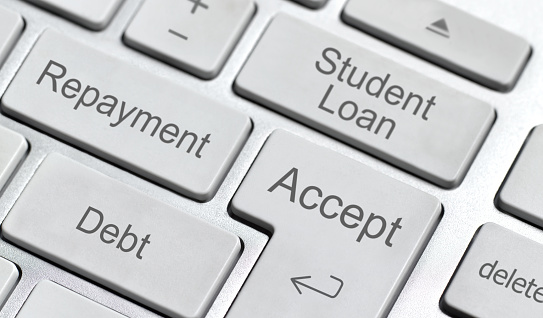The typical student loan payment, which averages up to $299 per month, according to the Federal Reserve, can be a significant amount to pay even in a stable economy.
With the coronavirus outbreak and the fallout to jobs across America, it may be difficult to make ends meet, much less pay off your student loans.
Whether your income was affected by the coronavirus outbreak or you simply don’t make enough money to afford all of your bills, there are ways to get help with student loan debt when you’re dealing with financial hardship.
We’ve put together this guide to help you read up on your options. Click a link to jump to the information most relevant to you.
For federal student loans:
- What you should know about federal student loans
- Coronavirus-specific federal student loan relief
- Income-driven student loan repayment plans
- Deferment for federal student loans
- Forbearance for federal student loans
- Federal loan consolidation
- What about interest rate cuts?
For private student loans:
- What you should know about private student loans
- Forbearance for private student loans
- Reduced payments for private student loans
- Private loan income-based repayment
What You Should Know About Federal Student Loans
When you take out federal student loans, the U.S. Department of Education is your lender. It can be helpful to know what kind of federal loans you have because certain loans will have different options for relief. There are currently four kinds of federal student loans:
- Direct Subsidized Loans: Subsidized loans are for undergraduate students with a demonstrable financial need.
- Direct Unsubsidized Loans: Undergraduate, graduate, and professional students are eligible for unsubsidized loans, regardless of their financial need.
- Direct PLUS Loans: PLUS Loans are for graduate students or parents borrowing on behalf of an undergraduate student.
- Direct Consolidation Loans: If you have several different federal loans, you can consolidate them into one loan with a Direct Consolidation Loan.
In normal circumstances, your federal loan becomes delinquent the first day after you miss a loan payment. If you’re delinquent for 90 days (about three months) or more, the loan servicer — the company that manages your loans and receives your payments — will report the missed payments to the major credit reporting agencies, affecting your credit score.
If you miss your payments for 270 days (about nine months) or more, your federal loans go into default. Loan default has serious consequences. The government can garnish your wages, seize your tax refund, and send your account to collections. Having an account in default can severely damage your credit, making it difficult to qualify for a loan, credit card, or even get approved for an apartment lease.
So, it’s important to be proactive if you think you’ll have trouble repaying your student loans. If possible, try to take advantage of the available federal student loan relief options before you fall behind.
If you have federal loans and are unable to afford your current monthly payments, there are five federal student loan repayment programs that can help.
1. Coronavirus-specific federal student loan relief
As part of relief efforts during the coronavirus outbreak, President Donald Trump and the Department of Education announced temporary student loan help on March 27, 2020. A provision in the Coronavirus Aid, Relief, and Economic Security (CARES) Act halts payments on federally-held student loans for six months.
Federal loan payments will be suspended until September 30, 2020. During that time, borrowers can stop making payments without incurring late fees or penalties, and without accruing interest. All federal student loans are eligible, with the exception of Federal Family Education Loans (FFEL) that are held by private lenders.
If you are currently pursuing loan forgiveness through Public Service Loan Forgiveness, this six-month period counts as qualifying payments toward the required 120 payments needed.
Even if your income has not been affected by the COVID-19 virus, you’re automatically eligible for this benefit. You can choose to make payments toward your debt during this time. If you do so, the entire payment will go toward the principal, allowing you to pay off your loans faster. You can make extra payments through your online account.
What’s next: The payment suspension is automatic. If you have federal student loans, there’s no need to do anything to take advantage of these changes. Your loan servicer will make the adjustments for you, and will send you a notification before payments begin again. You can visit the Department of Education’s page for more information.
2. Income-driven student loan repayment plans
If you can’t afford your current monthly payments — or if your income suddenly dropped — you may be eligible for an income-driven repayment (IDR) plan. Under these plans, the loan servicer extends your repayment term.
Instead of repaying your loan over the standard 10 years, you’ll repay your loan over 20 to 25 years. And, your loan servicer caps your payment at a percentage of your discretionary income. Some people even qualify for payments as low as $0 per month.
There are four different IDR plans:
- Income-Based Repayment Plan – For FFEL and Direct Loans; Parent PLUS Loans are not eligible
- Income-Contingent Repayment Plan – Direct Consolidation Loans (the only IDR option for Parent PLUS Loans, if they’re consolidated into a Direct Consolidation Loan)
- Pay As You Earn Plan – For Direct Loans only
- Revised Pay As You Earn Plan – For Direct Loans only
After you make payments for 20 to 25 years, depending on which IDR plan you choose, the remaining balance of your loans is forgiven. The discharged balance may be taxable as income, but the savings can still be significant.
What’s next: You can apply for an IDR plan online.
3. Deferment for federal student loans
If you need to postpone making payments temporarily, you can request a loan deferment. During a deferment, interest typically continues to accrue on the loan, but it gives you time to get back on your feet without having to worry about payments.
You may be eligible for a deferment if you’re facing economic hardship, are returning to school, are on active duty military service, or if you’re receiving unemployment benefits.
If you qualify for an economic hardship deferment, you can defer your payments for up to three years.
What’s next: Contact your loan servicer to see what forms you need to complete to apply for a deferment. If you’re not sure who your loan servicer is, call the Federal Student Aid Information Center at 1-800-433-3243.
4. Forbearance for federal student loans
Entering into forbearance is similar to deferment; you can temporarily postpone making payments on your student loans. But in certain circumstances, a forbearance is mandatory — meaning if you meet specific criteria, the loan servicer must grant your request for forbearance.
For example, if the total amount you owe each month for your federal student loans is 20% or more of your total gross monthly income, you can qualify for a mandatory forbearance for up to three years. Visit the Federal Student Aid website for the full criteria for mandatory forbearance.
What’s next: You must call your loan servicer to request a forbearance. Be prepared to provide documentation to support your request, such as past pay stubs, copies of medical bills, or a letter from your employer stating that you were laid off.
5. Federal loan consolidation
Another option to consider is consolidating your debt with a Direct Consolidation Loan. With this approach, you can combine all of your federal loans into a single loan. You can extend your repayment term to up to 30 years and enter into an IDR plan, dramatically reducing your monthly payments.
What about interest rate cuts?
You may have heard that the Federal Reserve — the central banking system for the United States — has reduced interest rates. While that may sound exciting for student loan borrowers, it’s unlikely to help you if you have existing student loans; your interest rates will stay the same for the life of your loans.
However, if you need to take out additional loans in the future, rate cuts may lead to lower rates on those loans.
What You Should Know About Private Student Loan Repayment Help
Private student loans are different from federal student loans in that they are held by commercial lenders rather than the Department of Education. If you have private student loans, you aren’t eligible for federal student loan repayment programs. However, some private lenders do offer financial hardship programs to borrowers.
With private student loans, you can go into default if you miss as few as three monthly payments — and the consequences can be severe. They’ll report negative information about you to the credit bureaus and can take you to court to collect payments — possibly garnishing your wages.
If you don’t think you can afford your payments, contact your lender right away and explain your situation. They may be able to work with you and come up with an alternative payment plan.
Below are three possible repayment options for private student loans if you’re dealing with financial difficulties.
1. Loan forbearance for private student loans
Loan forbearance terms vary from lender to lender. However, many private student loan lenders will allow you to temporarily postpone making payments if you’re dealing with a financial hardship, such as a job loss or medical emergency.
For example, if you have student loans from Sallie Mae, you could be eligible for forbearance for up to three months at a time and up to 12 months over the life of your loan.
What’s next: Visit your lender’s website and review its loan forbearance policies. Most lenders include information on how to request a forbearance and what details or documentation you’ll have to submit. Typically, you’ll have to call the lender’s customer service department and speak to a representative to get the process started.
2. Reduced payments for private student loans
In some cases, you may be able to get your lender to temporarily reduce your monthly payment, giving you more room in your budget. If your hours have been cut at work and you can’t afford your payments, some lenders will accept a lower monthly payment.
For example, Wells Fargo has a loan modification program for its private student loans. Eligible borrowers may temporarily or even permanently lower their payment amounts, making them more affordable.
What’s next: If your income has gone down, call your lender right away and explain your situation. If your job was affected by the coronavirus pandemic, specifically mention that development and ask for an alternative payment plan.
3. Private loan income-based repayment
Some lenders offer repayment plans that are based on your income. If your income is relatively low, you might qualify for a reduced monthly payment.
The Rhode Island Student Loan Authority (RISLA), which issues student loans nationwide, offers income-based repayment to eligible borrowers. With this option, your repayment term is extended to 25 years, and your monthly payment is adjusted annually based on your income and family size.
What’s next: If a lender offers income-based repayment options, they usually advertise that feature on their website. However, some lenders make special exceptions for borrowers facing financial difficulties. If you can’t afford your payments, contact your lender by calling its customer service department and request a reduced payment.
The Bottom Line on Finding Help With Student Loans
Not being able to afford your student loan payments is a terrible feeling, and entering into student loan default can have serious consequences.
If you’re proactive and reach out to your loan servicer to discuss your student loan repayment options, you might be able to find an alternative strategy. By either postponing your payments or reducing how much you owe, you can get more breathing room during tough financial times.

